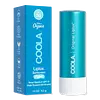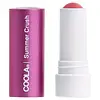COOLA Organic Liplux Classic Sunscreen Lip Balm SPF 30 Versus COOLA Mineral Liplux Tinted Lip Balm SPF 30
What's inside
What's inside
 Key Ingredients
Key Ingredients

 Benefits
Benefits

 Concerns
Concerns

 Ingredients Side-by-side
Ingredients Side-by-side

Butyl Methoxydibenzoylmethane 2.9%
UV AbsorberEthylhexyl Salicylate 4.9%
UV AbsorberOctocrylene 7.6%
UV AbsorberAloe Barbadensis Leaf Extract
EmollientAstrocaryum Vulgare Kernel Oil
Skin ConditioningBehenyl Behenate
EmollientButyloctyl Salicylate
Skin ConditioningCaprylic/Capric Triglyceride
MaskingCarthamus Tinctorius Seed Oil
MaskingCocos Nucifera Oil
MaskingCopernicia Cerifera Wax
Euphorbia Cerifera Wax
Aroma
Helianthus Annuus Seed Oil
EmollientLinoleic Acid
CleansingPersea Gratissima Oil
Skin ConditioningPhospholipids
Skin ConditioningPhytosterols
Skin ConditioningPolyhydroxystearic Acid
EmulsifyingRicinus Communis Seed Oil
MaskingRosa Canina Fruit Extract
AstringentRosmarinus Officinalis Leaf Extract
AntimicrobialRubus Idaeus Seed Oil
EmollientSimmondsia Chinensis Seed Oil
EmollientStevia Rebaudiana Extract
Tetrahexyldecyl Ascorbate
AntioxidantTheobroma Grandiflorum Seed Butter
Skin ConditioningTocopherol
AntioxidantButyl Methoxydibenzoylmethane 2.9%, Ethylhexyl Salicylate 4.9%, Octocrylene 7.6%, Aloe Barbadensis Leaf Extract, Astrocaryum Vulgare Kernel Oil, Behenyl Behenate, Butyloctyl Salicylate, Caprylic/Capric Triglyceride, Carthamus Tinctorius Seed Oil, Cocos Nucifera Oil, Copernicia Cerifera Wax, Euphorbia Cerifera Wax, Aroma, Helianthus Annuus Seed Oil, Linoleic Acid, Persea Gratissima Oil, Phospholipids, Phytosterols, Polyhydroxystearic Acid, Ricinus Communis Seed Oil, Rosa Canina Fruit Extract, Rosmarinus Officinalis Leaf Extract, Rubus Idaeus Seed Oil, Simmondsia Chinensis Seed Oil, Stevia Rebaudiana Extract, Tetrahexyldecyl Ascorbate, Theobroma Grandiflorum Seed Butter, Tocopherol
Titanium Dioxide
Cosmetic ColorantZinc Oxide
Cosmetic ColorantCocos Nucifera Oil
MaskingOlea Europaea Fruit Oil
MaskingCopernicia Cerifera Wax
Persea Gratissima Oil
Skin ConditioningJojoba Esters
EmollientOctyldodecyl Oleate
EmollientButyrospermum Parkii Butter
Skin ConditioningSchinziophyton Rautanenii Kernel Oil
EmollientAroma
Theobroma Cacao Seed Butter
EmollientHydrogenated Castor Oil
EmollientTheobroma Grandiflorum Seed Butter
Skin ConditioningOctyldodecyl PCA
EmollientHelianthus Annuus Seed Wax
Skin ConditioningAcacia Decurrens Flower Wax
EmollientPolyglycerin-3
HumectantRosmarinus Officinalis Leaf Extract
AntimicrobialHelianthus Annuus Seed Oil
EmollientPolyhydroxystearic Acid
EmulsifyingC18-38 Alkyl Hydroxystearoyl Stearate
EmollientStevia Rebaudiana Extract
Caesalpinia Sappan Bark Extract
Skin ConditioningSilica
AbrasiveIron Oxides
Mica
Cosmetic ColorantTin Oxide
AbrasiveTitanium Dioxide, Zinc Oxide, Cocos Nucifera Oil, Olea Europaea Fruit Oil, Copernicia Cerifera Wax, Persea Gratissima Oil, Jojoba Esters, Octyldodecyl Oleate, Butyrospermum Parkii Butter, Schinziophyton Rautanenii Kernel Oil, Aroma, Theobroma Cacao Seed Butter, Hydrogenated Castor Oil, Theobroma Grandiflorum Seed Butter, Octyldodecyl PCA, Helianthus Annuus Seed Wax, Acacia Decurrens Flower Wax, Polyglycerin-3, Rosmarinus Officinalis Leaf Extract, Helianthus Annuus Seed Oil, Polyhydroxystearic Acid, C18-38 Alkyl Hydroxystearoyl Stearate, Stevia Rebaudiana Extract, Caesalpinia Sappan Bark Extract, Silica, Iron Oxides, Mica, Tin Oxide
 Reviews
Reviews

Ingredients Explained
These ingredients are found in both products.
Ingredients higher up in an ingredient list are typically present in a larger amount.
Aroma refers to an ingredient, or mixture of ingredients, that impart or mask a flavor.
The name is slightly confusing. This is because INCI associates aroma with flavor instead of smell.
Here is the official definition from the The International Cosmetic Ingredient Dictionary and Handbook:
“Aroma is a term for ingredient labeling used to identify that a product contains a material or combination of materials normally added to a cosmetic to produce or to mask a particular flavor.”
INCI shows the only purpose of aroma to be "flavouring".
However, due to regulation differences, some companies may use aroma in place of parfum.
In Canada, this ingredient only has to be listed in concentrations above 1%.
Learn more about AromaCocos Nucifera Oil is obtained from the kernels of the coconut fruit. In other words, this is coconut oil.
Coconut Oil is rich in fatty acids with lauric acid making up the majority of these. It also contains linoleic acid. Due to this high fatty acid content, coconut oil helps trap moisture and soften skin.
Despite being antibacterial, coconut oil may not be great for acne-prone skin. It is comedogenic and may clog pores. This ingredient may not be safe for malassezia or fungal acne.
Note: Coconut Oil should not replace your sunscreen for UV protection. Studies show it only blocks about 20% of UV.
This oil is non-volatile and has a light scent.
The term 'fragrance' is not regulated in many countries. In many cases, it is up to the brand to define this term. For instance, many brands choose to label themselves as "fragrance-free" because they are not using synthetic fragrances. However, their products may still contain ingredients such as essential oils that are considered a fragrance.
Learn more about Cocos Nucifera OilCopernicia Cerifera Wax comes from a palm tree native to Brazil; another name for this ingredient is Carnauba Wax.
This ingredient is used to thicken texture and also leaves behind a film when applied.
Fun fact: This wax has the highest melting point of all natural waxes and low solubility.
Learn more about Copernicia Cerifera WaxHelianthus Annuus Seed Oil is the oil derived from the seeds of a Sunflower. Sunflower seed oil is non-fragrant. It is an emollient, meaning it helps to soften the skin.
Sunflower seed oil contains many fatty acids. The fatty acids found in sunflower seeds include (from highest amount to least): linoleic acid, myristic acid, palmitic acid, stearic acid, arachidic acid, oleic acid, and linolenic acid.
These fatty acids help the skin create ceramides. Ceramides play a role in repairing the skin barrier.
Helianthus Annuus Seed Oil helps moisturize the skin. This in turn helps the skin look more rejuvenated and smoother.
Sunflowers are rich in vitamin E.
Historians believe Indigenous cultures of North America domesticated sunflowers before corn. Thus they relied on sunflower oil for a variety of uses. One such use is moisturizing skin and hair.
Sunflower seed oil may not be fungal acne safe. We recommend speaking with a professional if you have any concerns.
Learn more about Helianthus Annuus Seed OilPersea Gratissima Oil is also known as avocado oil.
Avocado Oil has antioxidant properties. It is mostly made up of the glycerides of fatty acids. About 67% of these fatty acids is made up of oleic acid. Palmitic acid and linoleic acid are also present.
These fatty acids help hydrate and soften the skin. It may increase collagen content in the skin. Collagen helps keep your skin plump and firm. This ingredient helps reduce inflammation and has not shown to clog pores.
This ingredient may not be fungal-acne safe due to its high fatty acid content.
Avocados also have B vitamins, vitamin K, vitamin C, vitamin E, and potassium.
Learn more about Persea Gratissima OilPolyhydroxystearic Acid is a soft wax made from castor oil.
It is is a texture thickener, emulsifier, and film-former. Emulsifiers prevent ingredients from separating, such as oils and waters.
Polyhydroxystearic Acid may not be fungal acne safe.
Learn more about Polyhydroxystearic AcidRosmarinus Officinalis Leaf Extract comes from rosemary. Rosemary is native to the Mediterranean.
While Rosmarinus Officinalis Leaf Oil can be volatile due to its fragrant properties, the fragrance components are usually removed in the leaf extract.
Rosemary Leaf Extract contains many antioxidants such as rosmarinic acid and caffeic acid. Rosemarinic acid, a compound found in rosemary leaf, has been found to help soothe skin conditions such as eczema and acne.
Learn more about Rosmarinus Officinalis Leaf ExtractWe don't have a description for Stevia Rebaudiana Extract yet.
Theobroma Grandiflorum Seed Butter isn't fungal acne safe.